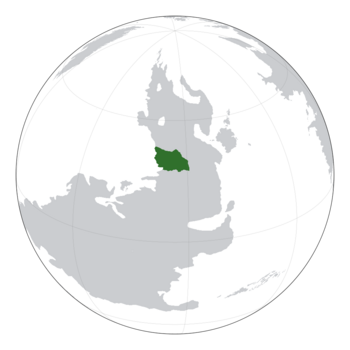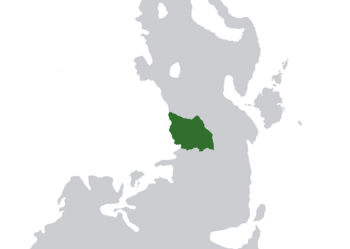Difference between revisions of "Hapatmitas"
m |
m |
||
| Line 97: | Line 97: | ||
At the start of the 12th century, the first migrations from Paleocacher to Hapatmitas began. Emigrants that settled in modern-day [[Dunangall]] often migrated on foot while others migrated by horse and wagon. On the Winnfiniu River, emigrants began even larger plantations than those during the prehistoric civilizations, even setting up villages that formed unofficial cantons. These cantons often joined together to form a confederal association dependent on the river. Over the century, the confederal associations across Hapatmitas began to transition into tribal states. Chiefs were often elected to direct the direction of the tribe’s food supply, economy, and defense. This system was customized to each association, with some cultural customs sometimes also being installed into government. However, the chiefs’ decrees often interfered with each other which unleashed many bloody wars. By the beginning of the 13th century, what historians coin as the [[Four Hundred Years]] began. | At the start of the 12th century, the first migrations from Paleocacher to Hapatmitas began. Emigrants that settled in modern-day [[Dunangall]] often migrated on foot while others migrated by horse and wagon. On the Winnfiniu River, emigrants began even larger plantations than those during the prehistoric civilizations, even setting up villages that formed unofficial cantons. These cantons often joined together to form a confederal association dependent on the river. Over the century, the confederal associations across Hapatmitas began to transition into tribal states. Chiefs were often elected to direct the direction of the tribe’s food supply, economy, and defense. This system was customized to each association, with some cultural customs sometimes also being installed into government. However, the chiefs’ decrees often interfered with each other which unleashed many bloody wars. By the beginning of the 13th century, what historians coin as the [[Four Hundred Years]] began. | ||
| − | === Four Hundred Years (c. | + | === Four Hundred Years (c. 1200–1686) === |
{{main|Four Hundred Years}} | {{main|Four Hundred Years}} | ||
| − | === Principality era ( | + | === Principality era (1691–1822) === |
{{main|Principality of Hapatmitas}} | {{main|Principality of Hapatmitas}} | ||
| − | === Imperialist period ( | + | === Imperialist period (1820–1889) === |
| − | === New Monarchy period ( | + | === New Monarchy period (1889–1939) === |
| − | === First Republican period ( | + | === First Republican period (1939–1950) === |
{{main|First Republic (Hapatmitas)}} | {{main|First Republic (Hapatmitas)}} | ||
| − | === Hapatmitasian Civil War ( | + | === Hapatmitasian Civil War (1946–1950) === |
{{main|Hapatmitasian Civil War}} | {{main|Hapatmitasian Civil War}} | ||
| − | === Second Republican period ( | + | === Second Republican period (1950–1972) === |
{{main|Second Republic (Hapatmitas)}} | {{main|Second Republic (Hapatmitas)}} | ||
| − | === Modern Hapatmitas ( | + | === Modern Hapatmitas (1972–present) === |
== Geography == | == Geography == | ||
Revision as of 21:02, 18 November 2023
Commonwealth of Hapatmitas Co-fhlaitheis Hapatmitas | |
|---|---|
Motto: Dìlseach gu deireadh. "Loyal to the very end." | |
Location of Hapatmitas (dark green) | |
| Capital | Donideann |
| Largest city | Sturgeon |
| Official languages | Eusazy |
| Ethnic groups (2022) | 89.2% Hapat 2.6% Paleocacherian 8.2% Other |
| Religion (2022) | 56.8% Christianity 28.7% Unaffiliated 6.1% Clovity 8.4% Other |
| Demonym(s) | Hapatmitasian |
| Government | Devolved unitary semi-presidential directorial republic |
| Ewan Thorcaill | |
| Nicola Ferguson Stewart Salmond | |
| Cormac Gilchrist | |
| Legislature | National Assembly |
| Formation | |
• Mass migration from Paleocacher | c. 1200 AD |
• Consolidated into the Principality of Hapatmitas | 4 September 1691 |
• Absolute monarchy proclaimed | TBD |
• Constitutional monarchy installed | TBD |
| TBD | |
| TBD | |
| TBD | |
| Area | |
• Total | 274,159 sq mi (710,070 km2) (40th) |
| Population | |
• 2022 census | |
• Density | 142/sq mi (54.8/km2) |
| GDP (nominal) | 2023 estimate |
• Total | ₵1.36 trillion (17th) |
• Per capita | ₵34,936 (18th) |
| HDI (2021) | very high · 16th |
| Currency | Hapatmitasian pìoban (₴) (HPB) |
| Time zone | AMT+12 (Donideann Standard Time) |
| Driving side | right |
| Calling code | +403 |
Hapatmitas (Eusazy: ![]() xapʌtmi:tæːz), officially the Commonwealth of Hapatmitas (Eusazy: Co-fhlaitheis Hapatmitas), is a country located in northern Ostlandet. The country is bordered by Paleocacher to the north and the Acernis Ocean to the west. With an area that spans 274,159 sq mi (710,070 km2) divided into 15 provinces, Hapatmitas is the 41st largest country in the world. The country has a population of around 38.9 million which mainly resides in the densely-populated Peannish. Its capital city is Donideann and its most populous city is Sturgeon, housing nearly 9 million residents. Other major cities including Peairtchu, Inverwyn, Crubagath, Inchmarlo, and Banchar.
xapʌtmi:tæːz), officially the Commonwealth of Hapatmitas (Eusazy: Co-fhlaitheis Hapatmitas), is a country located in northern Ostlandet. The country is bordered by Paleocacher to the north and the Acernis Ocean to the west. With an area that spans 274,159 sq mi (710,070 km2) divided into 15 provinces, Hapatmitas is the 41st largest country in the world. The country has a population of around 38.9 million which mainly resides in the densely-populated Peannish. Its capital city is Donideann and its most populous city is Sturgeon, housing nearly 9 million residents. Other major cities including Peairtchu, Inverwyn, Crubagath, Inchmarlo, and Banchar.
The region of modern-day Hapatmitas has been inhabited since 46 AD. The first Eusazy-speaking ethnic groups from Paleocacher migrated in the 9th century, including the early Hapats. These ethnic groups formed tribes, formal states that embodied an ethnic group and deeply competed for resources with each other over the rich and fertile land. These skirmishes are known as the Four Hundred Years in Hapatmitasian history. Many of these tribes’ economies were based on agriculture and fishing which supplied the commonplace trading goods of the region and formed associations. In 1624, with large mobilisation in prior years, the Hapats declared war on the western associations and successfully conquered a large portion of the region; the conquest led to the consolidation into the Principality of Hapatmitas in 1691. There were still many rivalries with southern states, which had also federated into single states, that continued to war with the principality.
During the 1810s, ultraroyalist factions began rising in the government, ultimately leading to the declaration of an absolute monarchy in Hapatmitas upon the abdication of the last Prince of Hapatmitas. The Kingdom of Hapatmitas expanded its borders south and expanded its trade economy across the Ostlandetian coast of the Acernis Ocean. The trading empire was extremely controversial for its ethics and was dismantled by a referendum to establish a constitutional monarchy instead in 1889. The Hapatmitasian Federation succeeded the kingdom, with the kings becoming relegated as cultural icons. Despite the new monarchy’s popularity in the 19th century, the 20th century brought republicanism in Hapatmitas to its height, whereas the legislature became dominated by republican parties through mass propaganda. In 1939, the monarchy was abolished and a democratic regime was created through a new constitution. While it was popular with the people, tens of hundreds of traditional political factions disagreed with the new system, causing hundreds of civil conflicts. In the fall of 1946, a civil war broke out between the liberals and conservatives. In 1950, liberals surrendered to the conservative faction, which effectively established a predominant conservative rule. The regime lasted until 1972 when the Commonwealth was proclaimed on the 4th of August, which dismantled the authoritarian administration.
Over forty years, Hapatmitas advanced its economy, military, technology, and government. The pharmaceutical and banking sectors grew tremendously, expanding the Hapatmitasian influence across the Acernis Ocean and Ostlandet. Hapatmitas also expanded its foreign relations and grew tourism throughout the country, designating Sturgeon as one of the most popular tourist destinations in the nation. The healthcare system in the country was also reformed, providing more equality, modern standards, and government investment. Education in Hapatmitas was also heavily improved, with hundreds of colleges joining together in 1994 to form university systems that became prestigious for their studies as well as more equalities in admission.
Hapatmitas is a member of the Ostlandet Union, Prosperity of 7, and Terraconserva Council of Nations. The country currently follows an active foreign policy while restraining itself from directly intervening in major conflicts. Most recently, in the invasion of Shaoyu, Hapatmitas supported the OUTFS materially and diplomatically. The country has historically been neutral in international conflicts but has advanced towards closer foreign relations after the civil war. The country also has a strict system in education and healthcare in part due to the post-authoritarian growth. As of 2023, Hapatmitas' diverse economy is currently the 18th largest by nominal gross domestic product (GDP) in Terraconserva; the country also has a very high Human Development Index; and has a score of 8.83 in the Global Democracy Index, making it the most democratic country on Ostlandet and one of the most democratic countries in the world.
Contents
- 1 Etymology
- 2 History
- 2.1 Pre-history and settlement (to c. 1100)
- 2.2 Four Hundred Years (c. 1200–1686)
- 2.3 Principality era (1691–1822)
- 2.4 Imperialist period (1820–1889)
- 2.5 New Monarchy period (1889–1939)
- 2.6 First Republican period (1939–1950)
- 2.7 Hapatmitasian Civil War (1946–1950)
- 2.8 Second Republican period (1950–1972)
- 2.9 Modern Hapatmitas (1972–present)
- 3 Geography
- 4 Government and politics
- 5 Economy
- 6 Demographics
- 7 Culture
- 8 Notes
Etymology
The name Hapatmitas' earliest mention was in 891 AD when the tribal nation was named for territorial sovereignty. The Old Eusazy word for "land" was roughly translated into mighta; the Hapat dialect of old Eusazy sounded like mita however, hence the latter's usage in Hapat Old Eusazy. The combination of the ethnic group's name and the word turned into Hapatmitas. In tribal Hapatmitas, many tribesmen were Clovic and wrote several meanings of the name; most suggested that the god of nature blessed the Hapats for great harvest seasons, rain, and sunlight, hence the name "mighta" to represent the agricultural might of Hapatmitas. Ultimately, leading up to the 16th century, these meanings were eventually lost following the transition towards New Eusazy and Christianity. It was only in 1928 that archaeologists found these divinations inscribed onto stone tablets in the Monadhruadh National Forest Reserve.
History
Pre-history and settlement (to c. 1100)
Historians and archaeologists believe that Hapatmitas has been inhabited for nearly 2,000 years. As part of the last few minor migrations from Ecros to Ostlandet, settlers usually arrived on large boats. The first tribal civilizations started growing in c. 120 AD. Mass plantations of wheat, barley, and various root tuber vegetables across the Winnfiniu and Forth rivers were created which grew the northern and southern regions of Hapatmitas. These settlements were often led by a group of people who had their respective expertise in various occupations: farmers, ironsmiths, and builders. Farmers comprised of majority of these populations, often followed by builders and then ironsmiths. Other smaller groups of settlers moved inland towards the Stiubhart Mountains and farmed using hill terrace methods that were effective in utilizing the mountain groundwater. Many civilizations also advanced in farming technology, including the plow which was first introduced to Hapatmitasian civilizations in 198 AD.
Infighting between the tribes started around 350 AD. Their farms became intertwined with one another due to unexpected growth and, as a result, farmers began fighting each other over the amount of land each one owned. Tribal leaders often refused to negotiate and went to war, devastating the food sources of the river civilizations and ending many tribes. In other cases, tribes formed temporary alliances to attack a common enemy. These alliances were the only means of cooperation and peace during this time. Many other skirmishes alike would follow through the rest of the prehistoric era of Hapatmitas.
The first great and major civilization in Hapatmitas was the Celiac Empire. The Celiacs were renowned for being nomadic, having a culture that strongly relied on the use of horses. As skillful farmers and merchants joined together at the helm, the civilization became largely economical. Celiacs also rapidly militarized and used their military power to invade surrounding neighbors to subjugate local magistrates into their sphere of influence. Celiac architecture also became a major component in modern Hapatmitasian architecture. The empire, at its height, expanded as far as past the Stiubhart Mountains. The Celiacs were taken over by the Lithorics in 1010. The Lithorics were brutal warriors, often committing unknown atrocities that brought the downfall of other great civilizations in Hapatmitas; the group was also the shortest-lasting great civilization of Hapatmitas, only lasting about 12 years.
At the start of the 12th century, the first migrations from Paleocacher to Hapatmitas began. Emigrants that settled in modern-day Dunangall often migrated on foot while others migrated by horse and wagon. On the Winnfiniu River, emigrants began even larger plantations than those during the prehistoric civilizations, even setting up villages that formed unofficial cantons. These cantons often joined together to form a confederal association dependent on the river. Over the century, the confederal associations across Hapatmitas began to transition into tribal states. Chiefs were often elected to direct the direction of the tribe’s food supply, economy, and defense. This system was customized to each association, with some cultural customs sometimes also being installed into government. However, the chiefs’ decrees often interfered with each other which unleashed many bloody wars. By the beginning of the 13th century, what historians coin as the Four Hundred Years began.
Four Hundred Years (c. 1200–1686)
Principality era (1691–1822)
Imperialist period (1820–1889)
New Monarchy period (1889–1939)
First Republican period (1939–1950)
Hapatmitasian Civil War (1946–1950)
Second Republican period (1950–1972)
Modern Hapatmitas (1972–present)
Geography
Climate
Environment
Urbanization
Government and politics
Hapatmitas is a unitary parliamentary directorial republic. National legislative power is vested into the unicameral National Assembly. Members of the National Assembly are elected through direct elections using the mixed-member proportional representation system. The Hapatmitasian political system operates under a framework laid out in the 1972 constitution. Constitutional amendments generally require a two-thirds majority of the legislature; the fundamental principles of the constitution are inscribed permanently. In particular, the MMP representation electoral system was a recent amendment to better suffix a proportionate representation of the growing Hapatmitasian population in the national legislature.
Under the semi-presidential directorial system, the head of state is collectively the Presidency of Hapatmitas, currently Douglas Johnstone, Nicola Ferguson, and Stewart Salmond. The Presidency is elected by universal adult suffrage for a four-year term. The First Minister, currently Cormac Gilchrist, is the head of government, appointed by the Presidency; the First Minister is also concurrently the leader of the largest party in the National Assembly and is responsible for administering the session's business. The Presidency has the power to dissolve the National Assembly or circumvent it by submitting referendums directly to the people. The Presidency is also vested with the responsibilities of appointing judges and civil servants, negotiating and ratifying international agreements, as well as serving as commander-in-chief of the armed forces. The Prime Minister administers domestic and public policy.
Historically, conservative factions were the primarily dominant political force in Hapatmitas, embodied by the New Republic Party which was the reigning and most important party of the Second Republic. However, after the abolition of the Second Republic in 1972, politics in Hapatmitas were dominated by three politically opposing groups - moderate conservatives, liberal and social democrats, and other minority parties. Today, Hapatmitasian politics are dominated by two political rivals - the National Coalition and the Social Democrats.
Administrative divisions
Hapatmitas is divided into 15 provinces (mòr-roinn) – one of these has a special status which the national government directly administers. As of 2023, the provinces are subdivided into NUMBER counties (siorrachd), which are optionally further fragmented into NUMBER municipalities (baile-mòr). The largest city in Hapatmitas, Sturgeon, was given the status of a metropolis (cathair-bhaile) in 2011 to properly govern the large municipality. Administrative authority at the provincial level is delegated to a government-appointed marshal (marasgal) who nominally appoints a governor (riaghladair) to de-facto govern on their behalf.
The geopolitical borders of each administrative division were created based on the borders of the historical kingdoms during the Four Hundred Years as well as geographical features such as rivers and low-altitude mountains. As part of a set of liberties outlined in the 1972 constitution, traveling between the provinces is unrestricted and does not require government approval. In regard to the law, provinces are grouped together to form concise circuits that are responsible for reporting to the Supreme Court in Donideann. Other political and infrastructural institutions report to the office of a Riaghladair.
Law and judicial system
Hapatmitas follows a civil law system. (TBC)
The judicial system of Hapatmitas is divided between regular civil and criminal jurisdiction and administrative courts with jurisdiction over litigation between individuals and public administration. The constitution of Hapatmitas ensures judicial independence from the government and Parliament provided that judges should only dictate a verdict purely by law, including acts, statutes, and methodical practice. Decisions can often be appealed to the Court of Appeals. The High Court, on the other hand, is the highest civil and criminal court responsible court responsible for the administration of justice. The Constitutional Court is responsible for judicial and constitutional review - it may declare legislation unconstitutional and render them ineffective. Together, the three highest courts form the Supreme Court.
Foreign relations
Military
Economy
Overview
Agriculture and mining
Manufacturing
Technology and science
Infrastructure and transport
Demographics
Ethnicities
Languages
Religion
Education
Health
Culture
Hapat culture has been strongly associated with the faith in Christianity. In part due to the Montcrabin Catholic missionaries that arrived in Hapatmitas during the 14th century, the culture of Hapatmitas has been largely surrounded around God and the belief in God's intuition in granting great harvests and prosperity to professions. The belief in individualism in Hapatmitas advanced the population's performance in literacy and art. However, despite individualistic ideals, Hapats often encourage each other to participate in governance and altruism. These combined faiths created a society based on merit and performance rather than aristocracy and hierarchy. Hapats in the faith of Clovity empathized with the Christian ideals and incorporated these beliefs as well. In a 2016 government survey, 82% of the Hapat population believed in cooperative ideals of individualism and collectivism.
The expression of culture expanded upon the start of the Principality era. Festivals, art, and architecture became popular during peacetime. The art of scriptures also became enrooted into Hapat culture, most notably in calligraphy and records. Hapats had a closer expertise, however, in physical refinery which included the occupations of blacksmiths, hunters, miners, and farmers. Architecture in Hapatmitas is strongly influenced by prehistoric civilizations as well as from foreign countries, such as Montcrabe. Linguistically, Eusazy is the commonplace language in Hapatmitas because of its official status. However, other languages including LANGUAGE 1 and LANGUAGE 2 are used by minorities in border regions of the country.
Television and media
Music
Architecture
Sports
Public holidays
Currently, there are 13 national public holidays in Hapatmitas. Some holidays are referred to as bank holidays, which most government agencies and banks close on as well. The government requires employers to function their business as a non-working day or to pay workers overtime if they work on that holiday. The government recognizes other unofficial holidays but does not recognize them as non-working days. Regionally, provincial holidays of culture or history may be declared with recognition if they pass the provincial legislature. For instance, three other bank holidays are recognized for the autumn, winter, and springtime seasons but vary by province; the only bank holidays every province observes on the same day are on 4 June, 4 August, and 19 August.

The thirteen national public holidays are:
| Date(s) observed | English name | Eusazy name | Remarks |
|---|---|---|---|
| 1 January | New Year's Day | Là na Bliadhn' Ùire | Celebrates the start of a new calendar year |
| 2 January | 2 January Day | Dàrna latha den Fhaoilleach | Official bank holiday; created in 2006 to extend the New Year's holiday |
| moveable | Good Friday | Dihaoine na Càisge | Commemorates of the crucifixion of Jesus Christ |
| moveable | Easter Sunday | Didòmhnaich na Càisge | Commemorates of the resurrection of Jesus Christ from the dead |
| 1 May | Labour Day | Là Làbarach | Celebrates the achievements of workers |
| 4 June | Summer Bank Holiday | Ceathramh latha den Ògmhios | An official national bank holiday for the Summer season |
| 1 July | National Day | Latha Nàiseanta | Celebrates the anniversary of the proclamation of the Commonwealth |
| 6 July | Civil Victory Day | Latha Buaidh Shìobhalta | Celebrates the anniversary of the end of the Hapatmitasian Civil War |
| 4 August | Opening Day | Latha Fosglaidh | An official national bank holiday; concurrent with the opening of Parliament and observed only every four years |
| 19 August | Remembrance Day | Latha Cuimhneachaidh | An official national bank holiday; commemorates the achievements of fallen soldiers |
| 4 September | Foundation Day | Latha Bunait | Celebrates the anniversary of the foundation of the first consolidated Hapatmitasian state |
| 30 November | Saint Duncan's Day | Latha Naomh Donnachadh | The feast day of Saint Duncan, patron saint of Hapatmitas |
| 25 December | Christmas Day | Latha na Nollaige | Commemorates the birth of Jesus Christ |








